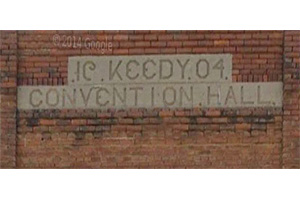
 |
 |
|||||||||||||||||||||||||||||||||||||||||||||||||||||||||||||||||||||||||||||||||||||||||
"In 1866 Worthy S. Streator, a prominent railroad promoter from Cleveland, Ohio, financed the region's first mining operation. Streator approached his nephew Col. Ralph Plumb at a railway station in December 1865 about overseeing a mining operation in central Illinois for him and several investors. Colonel Plumb agreed and arrived in the town then called Hardscrabble in February 1866. Success of the project required a rail line near the mines. Plumb and Streator "invited" Streator's friend, then Ohio Congressman James A. Garfield to sign on as an investor. In return, Garfield was expected to work with Robert C. Schenck, then the president of the American Central railroad, in getting the railroad to "bend their lines" to Streator." They didn't. Let's take a stroll. Renovations are good; tenants are also good.
Nice looking main street. Let’s check out the details.
It’s like some sort of parasite fastened itself to the face of the building:
The dreaded Green Shingle Buckaroo style.
Dang it, now where do I go for Rats?
Original tile and displays. Nothing special about them, except that most of the examples of the style are gone - so now they’re quite special.
That’s the most ridiculous “classical” facade I’ve seen in years.
Don’t get me wrong, I love the fact that it’s survived, and applaud their attempt to ennoble the street, but it’s clumsy. The lower floor doesn't match at all, but the color scheme suggests a 50s redo - or, if I had to lay money, something from the 30s. Based on the brick.
Sigh.
You know what that was.
“We use this in OCD therapy. If they can stare at the facade without getting nervous, we know the treatment’s going well.”
I CAN'T TAKE IT MUST PHOTOSHOP
Ahhhhh.
This must have been gorgeous. Those windows!
But now the H&R Block signage seems to be standing on tiptoe, and the windows have to peer over the top. It wasn’t redesigned as a tax preparer office, of course; those windows tell you it was retail, and redone in the 50s or early 60s. Gee, wonder where the staircase was:
Google returned later with happy news:
“When it senses a predator, the creature is able to change its coloring to appear as though it is a rock, instead of something edible.”
It's like the building was mummified.
“Don’t know if people will associate our store and the word FURNITURE with the idea of ‘home.’ What could we do about that? Some kind of symbol maybe?”
If I had to guess, I’d say the three-window building on the right was the original structure, and the longer building with more variegated brick was the extension made in boom times.
Next door, some local pride.
Hmm: some research indicates that the Woolley Drug was sold in 1918 to someone who wasn’t named Woolley. I’ll spare you the details, except to say that was 20 minutes of unrewarding googling and poring through old pharmacy industry magazines.
“Walter, c’mon. Really?”
If only they’d held on a little longer, the trees would have brought downtown back.
There are times when I know in my gut this was always an office building and never a hotel, and this is one of them. I almost hate to google around and see if I was wrong.
I don't think I am wrong.
Pile-up on Main:
What’s going on with the original building, though? The amount of jankyness on that second floor is practically unprecedented in this feature.
A classic main street mainstay:
More 60s than 50s, I think.
RICHIE
Looks like the original windows, and that suggests the entire structure was built in the late 20s, early 30s.
“Okay, if you two boys can’t get along, I’m splittin’ the building and leaving you both a part. You’ll have to get along to keep it maintained.
“The board of directors does not like the building. Can you change the design so it looks as if the building is gentling alighting on its site?”
This is the bluntest, most intimidating Masonic Temple I’ve ever seen:
You really get the sense there's a bald Egyptian guy in there conducting sacrifices by candlelight.
This I just love. That’s all.
Was it bricked up and boarded over time, or all at once? That’s one of the quintessential main street views, and it makes the past seem like something we can never see again.
Around the corner, something brilliant:
Cinema treasures has more pictures that show the building next door.You can see how it was mauled.
Once upon a time:
And that's what I saw in Streator. Have a look; give it my regards.
|
||||||||||||||||||||||||||||||||||||||||||||||||||||||||||||||||||||||||||||||||||||||||||
 |
 A city of 13,700 souls - and as is often the case, it looks as if it once held many more. It was born of coal. History:
A city of 13,700 souls - and as is often the case, it looks as if it once held many more. It was born of coal. History: 












































